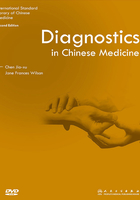
Section 4 Inspection of the Superficial Vein of the Index Finger
The superficial vein refers to the medial veins of the infant's index finger. This inspection means to examine the shape and colour of the veins along the palmar margin to detect pathological changes. This method is applicable for the diagnosis of infants under the age of three. Both index finger veins of the infants and adultcùn kŏu pulse belong to the lung channel of the handtaiyin. Alterations in the shape or colour of the index finger veins can reflect the changes of thecùn kŏu pulse. Therefore, inspection of the index finger veins can diagnose the pathological changes in infants' bodies, which is similar to inspection of thecùn kŏu pulse in adults.
1. Inspecting Method
(1) Three passes
From the palm to the tip of the finger, the first joint is the wind pass (fēng guān), the second joint is the qi pass (qì guān) and the last joint is the life pass (mìng guān) (Fig. 2-6).

Fig. 2-6 Three passes of the superficial vein on the infant's index finger
(2) Method
The infant must be carried to a place with full light; the practitioner should hold the wrist of the infant with the left hand, and then push lightly on the medial veins of the infant's index finger, several times with the right hand. The pushing should be directed from the tip of the finger (life pass) to the palm (wind pass). The pushing force should be mild and make the vein clearer for observation.
2. Clinical Significance
(1) Significance
It is helpful for examining the excess or decline of the qi and blood of thezang-fu organs, location and nature of the disease and predicting the prognosis.
(2) Characteristics of the normal index finger vein in infants
The colour is light red with a yellow tint and dimly revealed in the wind pass; it is not too obvious and not visible at all beyond the wind pass.
(3) Important points
Floating and deep distinguish exterior and interior. The colour of the veins differentiates cold and heat. Pale and dark stagnation determine deficiency and excess. The locality at the three passes indicates severity.
Abnormal manifestations and clinical significance of the superficial vein of the index finger:
A. Colour:
a. Bright-red: exterior pattern.
b. Purple-red: interior heat pattern.
c. Blue-green: convulsions or pain pattern.
d. Purple-black: obstruction of the blood vessels suggesting a severe case.
e. Pale-white: deficiency of the spleen or qi and blood, infant's malnutrition with accumulation.
B. Length:
a. The veins are only visible at the wind pass: pathogenic qi invading the collaterals; mild disease.
b. Visibility extends to the qi pass: pathogenic qi invading the channels; serious disease.
c. Visibility extends to the life pass: pathogenic qi invading thezang-fu organs; very serious disease.
d. Visibility extending through all passes toward the nail: A very dangerous and critical sign.
C. Floating and deep:
a. Floating and visible: exterior pattern.
b. Deep and indistinct: interior pattern.
D. Paleness and stagnation:
a. Light colour and no lustre: deficiency pattern.
b. Deep and dull colour: excess pattern.
E. Thick and thin:
a. Thick and obvious branch: excess pattern, heat pattern.
b. Thin and invisible branch: deficiency pattern, cold pattern.